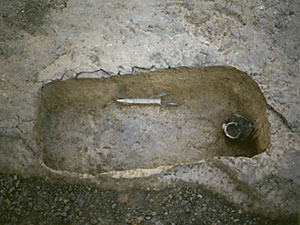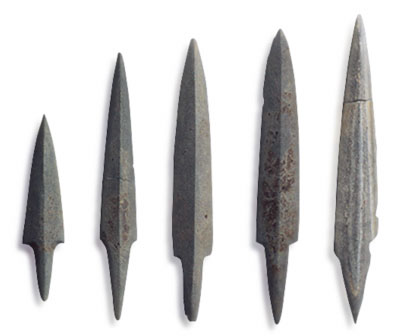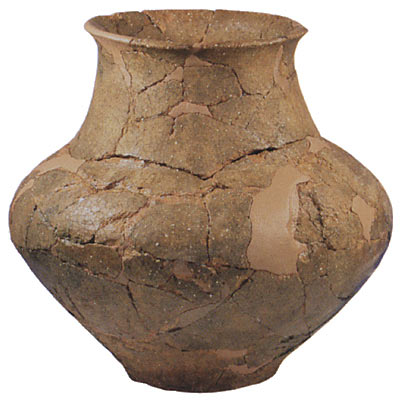Zasshonokuma:
Stone daggers in complete condition are recovered from graves. New materials are added to the debate over the start of the Yayoi period.

Polished stone daggers with handles, transmitted from the continent

Grave (SR0003) yielding a jar and stone dagger Although the coffin no longer remained, a jar was placed to the east (right, in photo). Stone arrowheads were laid near the dagger (top, in photo). Width and length of the burial pit was 0.8 by 1.5 m. | |

Stemmed polished stone arrowheads |

Vessel placed in a grave |
Zasshonokuma Site, Fukuoka City, Fukuoka Prefecture
Three stone daggers recovered in complete condition
Zasshonokuma is at the southern edge of the city of Fukuoka, atop a tableland more than twenty meters in elevation. Four wooden coffin burials from the Early Yayoi period were discovered at this location. There were no remains of the coffins or skeletal materials, but each of the four contained a jar-shaped vessel of Yūsu style pottery, and three of the four had a single polished stone dagger with handle, as grave goods. Polished stone daggers with handles are items carefully made by grinding a single piece of stone into the shape of an entire dagger, including the handle.
It is extremely rare for multiple stone daggers to be thus found, and moreover in complete condition. In discoveries made to date, usually only the tip of the blade is recovered from a grave, found in some cases thrust into the bone. This shows that stone daggers were used as weapons, and that a portion of the blade broke off at times and remained in the body.
Two methods of placement are inferred for the stone daggers, based on the conditions of the finds: some were lined up along with stone arrowheads beside the interred, while others were placed on the torso or atop the coffin lid. In addition, as each jar-shaped vessel was located on the eastern side of the burial, it is thought that the heads were likely placed in the same orientation.
Stone daggers from across the sea
Stone daggers are imitations modeled on bronze items for which they are meant to substitute, and are known to be distributed from the Liaotung region to the Korean peninsula. In Japan, they are thought to have been transmitted from across the seas, at a time when bronze daggers were extremely rare, primarily to areas near the Korean peninsula such as Tsushima and the northern part of Kyushu. This corresponds with the period when paddy agriculture first began in northern Kyushu, and once metal items started to diffuse in numbers from the end of the Early Yayoi they gradually disappear.
The three items differ in their sizes and shapes, but the one with bands at the center of the grip (left, in the photo) is thought to be an imitation in which the characteristics of the bronze dagger from which it was copied have become decorative in nature. Two candidates proposed as its original are the Liaoning and Chinese styles of bronze daggers. As the periods in which they were used are roughly known, if a determination between the two can be made it would serve as clue for the age of the stone dagger. This would address the very important problem of giving an absolute date for the Yayoi period by archaeological methods.
In considering how the group which brought the stone daggers to Zasshonokuma was related to the dawn of Yayoi culture, we are provided with a splendid opportunity for reexamining the problem of the start of the Yayoi period, from the vantage point of East Asia. (Horizono Takashi)
